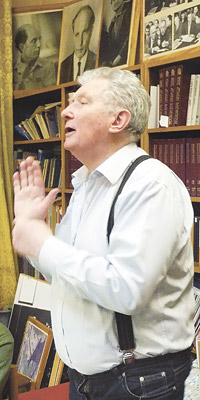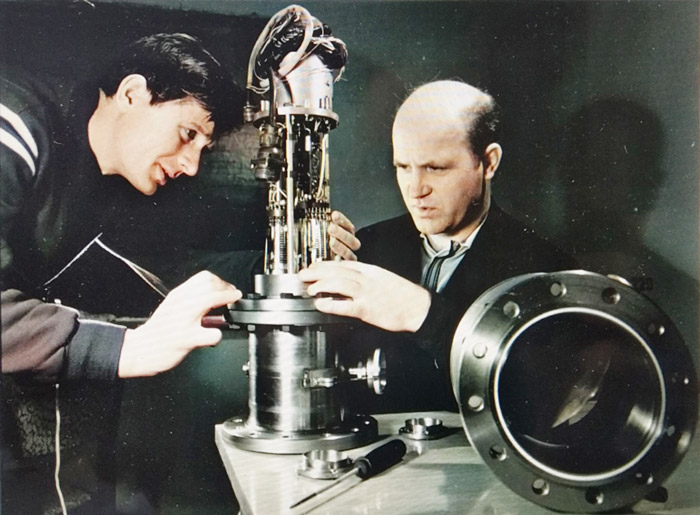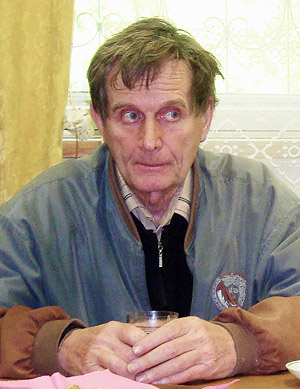
Electronic english version since 2022 |
The newspaper was founded in November 1957
| |
|
Number 18 (4615) |
The history of science - in the first person
Points on the life graph
15 years ago, a series of lectures "History of discoveries - in the first person" started with A. V. Strelkov's story about ultracold neutrons. The history of the discovery of ultracold neutrons and their amazing properties has been covered more than once, but in that lecture of Aleksandr Vladimirovich there was also something that was included neither in newspaper articles, nor in his 1996 preprint, but should be preserved as a living history of our Institute.
In the evening of 28 March 2007, it was noisy, fun and crowded in the exhibition hall of the JINR Museum. FLNP Leading researcher A.V.Strelkov announced right from the door that he was only one of the authors of the discovery and far from being the first…
 Genrikh Vardenga, as Director of the museum, opened the meeting.
Genrikh Vardenga, as Director of the museum, opened the meeting.
"Dear friends! I will allow myself a small introductory word. In the life of our museum, this is the second series of lectures, the first one has been devoted to the history of science in general, from antiquity to the present day, unfortunately, it has not fully been implemented. The new series is much closer to our history, to the history of our Institute. It seems significant to me that we start this series with ultracold neutrons, at very low, almost zero energies - 10-3 kelvin that corresponds to about 10-7 electronvolts. We all know that we have a synchrophasotron for 10 billion electron volts; 1010 protons and 10-7 neutrons - that is, nucleons have covered a fantastic energy range - 17 orders of magnitude in the work of our Institute. And each Laboratory in this range has found its place. Such, one might say, is the epigraph to our series and to today's meeting."
B.S.Neganov:
"Unfortunately, little has been learned."
Genrikh, in an accommodating spirit:
"Well, why not enough? And addressing the audience, "The seminar has not started yet and Boris Stepanovich is already starting to argue!"
Genrikh grew up in the Caucasus, where besides choral singing and lezginka, the most important of arts is the art of toasting. And so, his enthusiastic speech flew and foamed like sparkling wine, filling, in order of seniority and significance, the glasses of the recipients of the Institute that unites us all and of the Laboratory of Neutron Physics where these ultracold neutrons were first discovered. Finally the praises reach the authors of the discovery.
"I will allow myself one more little digression. When our museum was developed, together with Vera Zakharova we went around Laboratories and begged for exhibits for our museum and I must say that in the Laboratory of Neutron Physics, with a special generosity, we got... this operating model of a pulsed reactor... When we came to Sasha Strelkov, to Aleksandr Vladimirovich, he told us about ultracold neutrons with such enthusiasm, with such a twinkle! And then he brought a sealed tin can - do you remember, Sasha? - this is what we gave Ilya Mikhailovich as a present - half a can of neutrons! I will not intrude into the scientific side, Sasha will tell you everything, but I am glad that our series begins with the history of this discovery ... And now I want to applaud another author of this discovery - Vladislav Ivanovich Lushchikov! And let's hear about what they did."

A.V.Strelkov and V.I.Lushchikov, 1971. Photo by Yury Tumanov.
Lev Borisovich Pikelner, taking advantage of the pause that followed, says, "Since we have transferred the OPERATING IBR model to the museum and today our reactor has been shut down and we have nothing to work on..."
"Are you offering to return it?"
"Since we haven't got another operating facility…"
"Well, why not, Lyova? You have got a huge model that you took to the Polytechnic University for an exhibition!"
"No, this is not that, this is a flying saucer, but here is an OPERATING facility!"
"Very well," Vardenga agrees, wiping her tears.
"We'll discuss it later," Pikelner agrees and everyone looks at the speaker.
 "I want to make it a little clear," Aleksandr Vladimirovich began. "I don't know how it is in the area of high energies, we stopped at 10 GeV in Dubna, TeV left for the West, but today with ultracold neutrons we have reached an energy at which a neutron flying up can only rise to a height of 12 microns, it is thinner than a human hair.
"I want to make it a little clear," Aleksandr Vladimirovich began. "I don't know how it is in the area of high energies, we stopped at 10 GeV in Dubna, TeV left for the West, but today with ultracold neutrons we have reached an energy at which a neutron flying up can only rise to a height of 12 microns, it is thinner than a human hair.
"To what height?" Boris Stepanovich asks again.
"12 microns."
"Jump up?"
"Jump up!"
"Really? I thought at least half a meter."
"There is half a meter, too. This is the lower bound."
Vardenga exclaims enthusiastically:
"22 orders are covered!"
Neganov notes:
"Nevertheless, we are not discovering anything new in principle. That's what is sad."
"Boris Stepanovich, this is an old discussion," Strelkov winces...
These romantics in science, the knights of exact knowledge are like two drops of water, but Strelkov is carried away by the very process of cognition, while Neganov focuses on the result and points to its absence.
"And one more clarifying to the words beginning with di ..." Strelkov suddenly falls silent, as if remembering something. "Director of the museum..."
"My name is Genrikh Lyudvigovich," Vardenga prompts. "You can just call Genrikh."
"Now for the first person. I have great respect for Vladislav Ivanovich, he is much smarter than me, but he is not the first author of this discovery! And he agrees with great joy! The first author, of course, is Fyodor Lvovich Shapiro. If not for him, nothing would have happened. He was the initiator. You are walking along the corridor, he is luring you into the office with his finger, to sit down on the sofa - I'll tell you something now ... And he calls for enthusiasm. This was how I was recruited, Vladislav Ivanovich, me - Pokotilovsky Yury Naumovich, an orphan graduate student ... Four people responsible for the technical side of the matter greatly helped us. They are Evgeny Nikitovich Kulagin, that is present here, a laboratory assistant at that time, our famous photo artist Seryozha Negovelov, Sasha Ivanenko, who prepared the electronics we worked on in just a few hours and Boris Ivanovich Apollonov who serviced vacuum equipment."
It was an amazing time. The end of July - the beginning of August, everyone fled on vacation, there was one reactor shift left and the next shift already had tickets to the south. Everything was done in just two weeks. The first week was coming to an end, statistics were afoot, there were neutrons - we still doubted whether they were the right ones or not, test experiments were coming up - and suddenly we noticed that the vacuum in the pipe had deteriorated ... Discharges started, we did not know what had happened and the week dismissed for measurements, during which the reactor had worked only for us, ended. At the insistent request of Fyodor Lvovich - he was then Deputy Director of the Laboratory and Frank was our Director, we might take one more week for measurements.
This was decided at the well-known Directors' meeting on 24 July 1968, at which Fyodor Lvovich argued alone with the Chief Engineer and Director, with everybody ...
Ilya Mikhailovich was STRONGLY AGAINST shifting the reactor shutdown date. He addressed both me and Fyodor Lvovich, "Young people, there are no blitzes in science, science occurs in the silence of Laboratories, in a year and a half or two we will modernise the reactor, then you may repeat this experiment.
And Fyodor Lvovich wanted to do it right now. As though he saw it in a crystal ball: results were ready on 5 January and a month later the Munich group confirmed the effect...
This is an amazing story! Suddenly, during a meeting, Maria Semyonovna Lisitsyna, our secretary, called me and said, "Fyodor Lvovich is calling you..." Fyodor Lvovich came out of Frank's office and said, "Sasha, it's a disaster... Ilya Mikhailovich says: it's clear why your vacuum is bad - there is a huge amount of hydrogen-containing substances, radiation, hydrogen flies out, what do you want?"
Fyodor Lvovich asked, "Sasha, I can hold out for another forty minutes, find out, please, what is in the neutron guide, air or hydrogen." We managed to make an analysis of the gas in forty minutes and conveyed that it was air, not hydrogen. After that, Fyodor Lvovich went on the offensive, since the hole in the neutron guide was easy to eliminate. The history of science develops very RAPIDLY, it does not fit into any smooth analytical forms and everything depends on the enthusiasm of people, their passion...
Since we have almost a home environment here ... Some parts of the facility had to be urgently redesigned on Sunday, when the workshop doesn't work. Fyodor Lvovich said, "Maybe you can regrind it on a manufacturing lathe? If Matsuev, Head of our workshops, comes, he hardly comes to work on Sundays, but if he does, I will distract him." We opened the turning shop, figured out how and what was spinning and Corresponding Member Shapiro was standing at the entrance to the Laboratory in panic. And when I went to him with the finished part, he admitted, "I have never thought that on Sunday the work of the machine can be heard so loudly..."
Everyone who knew Fyodor Lvovich, owes him the wonderful physics that he instilled in them... The whole Laboratory lived on his ideas. We have been struggling for two years to give our Laboratory the name of Fyodor Lvovich, so that it would be not only the Laboratory named after Frank, who was its face, but also Shapiro who of course was its essence. We went to Directorate, wrote letters. We were supported by eight academicians. Well, and Directorate ... "Why on earth did you suddenly wake up?" Well, we woke up..."
Time is running out, we will not be here and after us no one will get priorities straight. The Laboratory - both in subject matter and in style and in spirit - was developed by Fyodor Lvovich. Of course, Ilya Mikhailovich was a wonderful person, he created a climate in the Laboratory, but there has never been such a thing as to come and to say something on physics. On the contrary, he said, "Sorry, I'm old, once more, please ..." He was frank, did not masquerade. Although he understood, of course, that he was a Nobel Prize winner, an outstanding personality...
I made such a long introduction since I wanted to declare our pain ... We are honest experimenters and it is our duty to put the right dots on this life graph, not to drag them anywhere, without looking back at what Princess Marya Aleksevna will say ... In order for Fyodor Lvovich to be on this graph in his place - just where we want. We want to consolidate this place of Fyodor Lvovich in the history of the Laboratory. Directorate says, "What if everyone does this?" What does "everyone" mean?! If you think that a person is worthy... We think that there is no one like Fyodor Lvovich... And there is already a precedent for a double name - this is the Veksler-Baldin Laboratory. In the West, this is generally a common thing: Institute Laue-Langevin, Rutherford Appleton Laboratory...
"And now about ultracold neutrons," the speaker said, sobering up...
Alexander RASTORGUEV